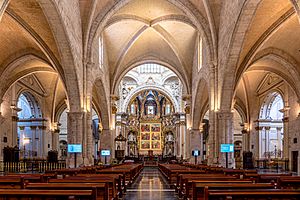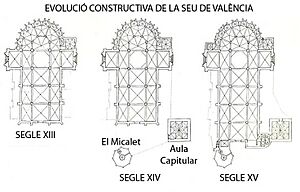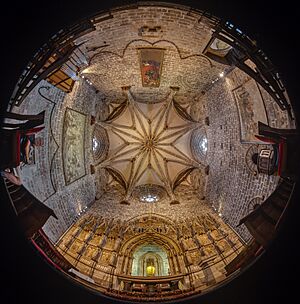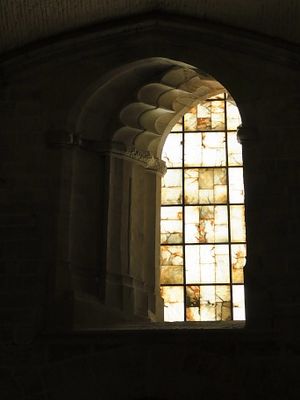Valencia Cathedral facts for kids
Quick facts for kids Valencia Cathedral |
|
|---|---|
| Metropolitan Cathedral-Basilica of the Assumption of Our Lady of Valencia | |

North-west façade, at dawn.
|
|
| 39°28′33″N 0°22′30″W / 39.47583°N 0.37500°W | |
| Location | Valencia |
| Country | Spain |
| Denomination | Catholic Church |
| History | |
| Status | Cathedral, minor basilica |
| Dedication | Assumption of Mary |
| Architecture | |
| Architectural type | Church architecture |
| Style | Valencian Gothic |
| Groundbreaking | 22 June 1262 |
| Administration | |
| Archdiocese | Valencia |
The Valencia Cathedral, also known as St Mary's Cathedral, is a large Catholic church in Valencia, Spain. Its full name is the Metropolitan Cathedral–Basilica of the Assumption of Our Lady of Valencia.
This important building was officially opened in 1238. It was dedicated to Saint Mary by King James I the Conqueror. The cathedral was built on the site of an older church. This old church had been turned into a mosque when the Moors ruled the area.
The main style of the cathedral is Valencian Gothic. However, it also has parts that show Romanesque, French Gothic, Renaissance, Baroque, and Neoclassical styles.
Inside, you can see many paintings from the 1400s. Some were made by local artists, and others by famous Italian Renaissance artists. These artworks were ordered by Pope Alexander VI, who was a cardinal at the time.
One of the most famous things about the cathedral is a special cup. Many people believe this cup is the true Holy Chalice, also known as the Holy Grail. It is kept safe in one of the cathedral's chapels.
Contents
History of Valencia Cathedral
Most of the Valencia Cathedral was built between the 1200s and the 1400s. The main style used during this time was Gothic. However, building the cathedral took many centuries. Because of this, you can see a mix of different art and building styles. These styles include early Romanesque, Valencian Gothic, Renaissance, Baroque, and Neoclassical.
From Mosque to Cathedral
Digs at the Almoina Archaeological Centre have found parts of an old Visigothic cathedral. This church later became a mosque under Moorish rule. Records show that the mosque-cathedral was still standing for some decades after the Christians took over Valencia in 1238. It even had Arabic writings on its walls.
On June 22, 1262, the bishop, Andreu d'Albalat, decided to tear it down. He wanted to build a new cathedral in its place. The new design was made by the architect Arnau Vidal. It is thought that the old Muslim mosque was where the central part of the cathedral is now. The Apostles' gate might have been the mosque's entrance. The Almoina gate could have been its prayer niche.
Stones for building the cathedral came from nearby places like Burjassot and Godella. Some stones also came from farther away, like Benidorm and Xàbia. These stones were brought by boat.
The cathedral looks simple and serious for a few reasons. It was built quickly to show Christian control over the area. Also, it was not built by a king. Instead, it was built by the local wealthy citizens.
How the Cathedral Was Built
Even though it has many styles, the cathedral is mostly a Gothic building. It has a cross shape, with arms extending north and south. The center part is covered by an eight-sided tower, called a cimbori. It also has a walkway around the altar area and a rounded end.
Building started in the late 1200s, around 1270–1300. This was happening while the old mosque was being taken down. The first part finished was the walkway around the altar and the Romanesque Almoina gate.
Later Additions and Changes
Between 1300 and 1350, the central part of the cathedral was completed. Its western side was built up to the Baroque Apostles' Gate. Three of the four main sections and the cross-shaped arms were also built. The central eight-sided dome, or cimbori, was also started.
The old chapter house, where church leaders met, was built between 1356 and 1369. Today, this is the Holy Grail Chapel. The Miguelete Tower, also known as El Miguelete, was also built. These parts were first separate from the main church.
In 1459, architects Francesc Baldomar and Pere Compte made the church bigger. They added a new section called Arcada Nova. This finally connected the chapter house and the Micalet tower to the rest of the cathedral. This made the cathedral about 94 meters (308 feet) long and 53.65 meters (176 feet) wide.
The Renaissance period (1400s–1500s) did not change the cathedral's structure much. However, it added many beautiful paintings and sculptures. Examples include the high altar and the Resurrection chapel.
Baroque and Neoclassical Styles
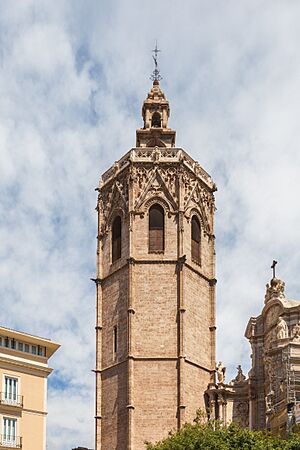
During the Baroque period, a German designer named Konrad Rudolf created the main door in 1703. It is known as the Iron gate because of its iron fence. He could not finish it due to a war. Sculptors Francisco Vergara and Ignacio Vergara completed the work. The door has a curved shape that creates a special view. This view was changed in the 1900s when nearby buildings were removed to make the square bigger.
In the late 1700s, a plan began to update the cathedral. The goal was to make it look uniformly Neoclassical. At that time, the original Gothic style was not seen as beautiful. Work started in 1774, led by architect Antoni Gilabert Fornés. This project changed both the building and its decorations. Pointed towers were removed from the outside. The Gothic structure was covered with plaster and other classical-looking elements.
Modern Restorations
In 1931, the Spanish government declared the church a historic and artistic landmark. However, during the Spanish Civil War, parts of it were burned. This caused it to lose some of its decorations. The choir, which was in the middle, was taken apart in 1940. It was moved to the back of the main altar.
In 1970, some buildings attached to the cathedral were torn down. This was done to help the cathedral look more like it did before. Also, parts that were not very important or beautiful were removed.
In 1972, work began to remove the Neoclassical parts. The goal was to bring back the original Gothic look. Only most of the chapels around the altar and some sculptures at the base of the dome were kept in the Neoclassical style.
After several repairs, the cathedral is now in good condition. This is especially true after a special exhibition in 1999. The regional government of Valencia again declared it a cultural landmark.
Relics of the Holy Chalice
A special cup, believed by many to be the true Holy Chalice or Holy Grail, is kept in one of the cathedral's chapels. This chalice has been used by many popes. Most recently, Pope Benedict XVI used it on July 9, 2006. This ancient cup, possibly from the 1st century, was given to the cathedral by King Alfonso V of Aragon in 1436.
Interesting Discoveries
Next to the Chapter Room, there is a round chapel. Behind a classical-style doorway, it has three closets filled with relics. You can also see paintings from the main altar that were hidden for many years. These religious paintings were only found in 1874 when the main altar was cleaned.
At the front of Valencia Cathedral is the Barchilla Arch. This arch connects the cathedral to the Archbishop's Palace. On the right side of this arch, there is a Roman stone. This stone shows that the arch had the official measurements of that time. Finally, during digs to make the cathedral bigger, parts of old Roman buildings and streets were found.
Music at the Cathedral
Valencia Cathedral was very important for sacred music in Spain. Many famous composers worked there as mestre de capella, which means "master of the chapel music." A music expert named Josep Climent Barber has done a lot of research on the music from Valencia Cathedral.
See also
 In Spanish: Catedral de Santa María (Valencia) para niños
In Spanish: Catedral de Santa María (Valencia) para niños


